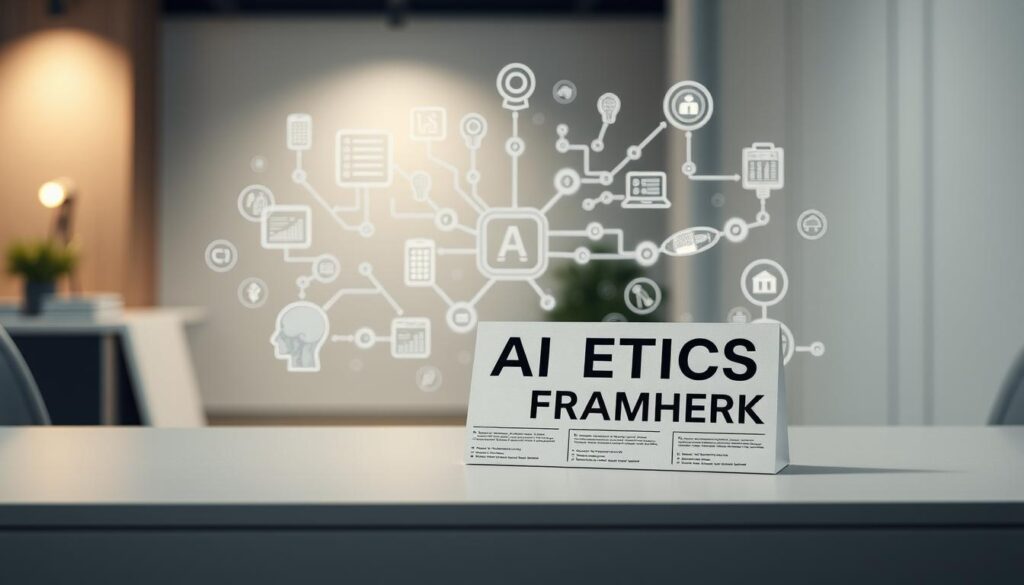Could the technology saving lives today become our greatest threat tomorrow? The same systems that diagnose cancers with 95% accuracy also power autonomous weapons. These weapons never sleep and never question orders. This shows us the dark side of humanity’s most transformative innovation.
Manufacturing leaders see the benefits of advanced algorithms. They believe these tools are crucial for survival, according to Logicalis US research. But MIT professor Max Tegmark warns that we’re creating powerful tools without wisdom. He fears we might end up like the Terminator scenario, where brilliant tools are used carelessly.
Medical breakthroughs show the good side of AI. Neural networks can detect heart disease years early. Robotic surgeons can perform delicate operations. But, defense contractors are testing drones that choose targets without human oversight.
Key Takeaways
- Advanced algorithms present both revolutionary benefits and unprecedented risks
- Industry adoption outpaces ethical guardrails in critical sectors
- Medical applications demonstrate responsible implementation models
- Military systems highlight urgent need for accountability standards
- Public engagement must shape policy before technologies mature
Understanding AI and Its Impact on Society
Artificial intelligence has grown from ideas to real tools changing our lives. It started with John McCarthy’s 1955 Dartmouth workshop, where “AI” was first mentioned. Now, AI is in our phones and factories, making us think about responsible AI development.
The Rise of Artificial Intelligence
AI has come a long way. Early systems followed rules, but machine learning changed everything. IBM’s neural networks showed computers could learn from experience, not just code.
Today, deep learning models mimic our brains, recognizing patterns in:
- Medical imaging analysis
- Financial fraud detection
- Supply chain optimization
Key Applications of AI Today
AI is making a big difference in the world. Siemens cut equipment failures by 35% with predictive maintenance. Microsoft’s AI for Health speeds up medical data analysis 8x faster.
AI is used in:
- Personalized education platforms
- Smart energy grids
- Agricultural drones
“44% of US manufacturers now use AI-powered quality control systems, according to Logicalis’ 2023 industrial survey.”
Potential Benefits of AI
AI can bring big benefits if used right. In healthcare, AI finds cancer early with 94% accuracy. Cities see 20% less pollution with AI traffic management.
The main benefits are:
- Scalable problem-solving: Handling huge datasets
- Continuous improvement: Getting better over time
- Risk reduction: Preventing accidents
These points show why machine learning ethics are crucial. The same tech that helps find new medicines could also lead to misuse if not handled carefully.
Ethical Dilemmas in AI Development
Artificial intelligence is changing our lives in big ways. But, it raises big questions about who’s to blame when AI goes wrong. From making health decisions to affecting criminal justice, we need to talk about AI’s ethics fast. The debate is between innovation and accountability, efficiency and fairness, and progress and privacy.
Accountability and Responsibility
The COMPAS recidivism algorithm showed a big problem: it wrongly labeled Black defendants as high-risk more than white ones. This raises a big question: who’s to blame for AI mistakes? Google’s Model Cards try to show AI’s limits, but IBM’s old hiring tool shows how hard it is to point fingers.
In healthcare, AI’s mistakes can be deadly. Epic’s sepsis prediction model was wrong for people of color, putting them in danger. This shows we need to know who’s in charge of AI projects.
Transparency in AI Decision-Making
Many AI systems are like “black boxes,” making decisions we can’t understand. The MIT Media Lab found facial recognition systems were wrong more often for darker-skinned women. This lack of transparency is a big problem in policing and jobs.
“When algorithms dictate life-altering decisions, transparency isn’t optional—it’s a human right.”
Some groups are working on making AI explainable, but it’s not happening fast enough. The push for keeping algorithms secret versus the need for openness is a big challenge in AI ethics.
Bias in AI Algorithms
Amazon’s old recruitment tool showed how past data can harm AI. It unfairly judged resumes with words like “women’s chess club.” These biases come from bad data, wrong problem framing, and poor testing.
To fix these biases, we need:
- Diverse teams to spot problems
- Third-party checks on important systems
- Always watching for bias
Tools like IBM’s AI Fairness 360 are helping, but we need more. As AI gets more complex, keeping ethics in AI is harder but more important.
Data Privacy and Security Concerns
Artificial intelligence systems need lots of personal data to work well. This raises big issues for keeping users’ trust and following new rules. Big problems like the Equifax breach and Clearview AI’s $9 million settlement show what can go wrong.
The Importance of Data Protection
Companies must do more to keep data safe. The EU’s GDPR costs businesses about $1.3 million a year. ISO 27001 gives clear rules for handling data. Clearview AI’s mistake shows the dangers of not following these rules.
Healthcare is especially at risk, as seen with Anthem’s 2015 breach of 79 million patient records. These examples highlight why responsible AI development must follow AI and privacy challenges to avoid big problems.
Navigating Consent in Data Usage
Big tech companies have different views on user permissions. Apple lets users control data sharing, while Meta keeps collecting a lot of data. This makes us wonder what real consent in AI means.
“Transparent consent mechanisms are non-negotiable in ethical AI systems.”
New ideas like dynamic consent models give users more control over their data. These ideas help solve ethical considerations in artificial intelligence while keeping AI useful.
Case Studies: Failures in Data Security
The 2017 Equifax breach showed how old software can be a big problem. It affected 147 million Americans. This shows how important keeping systems up to date is.
Here are some key lessons from big breaches:
- Regular system updates prevent 85% of common exploits
- Multi-factor authentication reduces unauthorized access by 99%
- Employee training decreases phishing success rates by 60%
These examples show why AI ethics guidelines must focus on managing risks and keeping up with new tech.
The Role of Regulation in AI Ethics
Artificial intelligence is changing the world, and governments must find a balance. They need to ensure innovation and accountability. This section looks at how regulations aim to solve AI’s ethical problems while pushing technology forward.

Current Regulatory Frameworks
There are three main ways to regulate AI globally:
- EU’s Risk-Based Model: The AI Act bans “unacceptable risk” applications like social scoring systems
- US Sector-Specific Rules: Executive Order 14110 focuses on safety standards for critical infrastructure
- China’s Targeted Controls: Deep synthesis regulations require watermarking AI-generated content
New York City’s Local Law 144 shows local efforts to regulate AI. It requires bias audits for hiring algorithms. IBM’s AI Ethics Board is an example of companies taking action before laws require it.
The Need for Global Standards
Creating global AI standards is a big challenge. It involves:
| Region | Focus Area | Enforcement Mechanism |
|---|---|---|
| European Union | Fundamental rights protection | Fines up to 6% of global revenue |
| United States | National security concerns | Voluntary compliance frameworks |
| Asia-Pacific | Technology leadership | Export controls on AI chips |
The Partnership on AI is working with over 100 organizations. They aim to create shared AI ethics guidelines. But, different countries have different priorities, making universal standards hard to achieve.
Stakeholder Engagement in Policy Development
Creating good AI ethics frameworks needs input from:
- Tech developers who know how systems work
- Legal experts who understand the laws
- Civil society groups that speak for vulnerable people
China’s approach to AI regulation shows how to balance things. It requires real-name verification for AI services but also has public consultations. This way, regulations protect users and support innovation.
Addressing Societal Impacts of AI
Artificial intelligence is changing our lives in big ways. It affects communities and economies, and we need to act fast. We must work together to solve these problems, using responsible AI development as our guide.
Job Displacement and Economic Considerations
McKinsey says 12 million workers might need new jobs by 2030 because of AI. But, some jobs will grow:
- Healthcare AI roles increased 45% since 2020 (Brookings)
- Robotics maintenance jobs surged 32% in US manufacturing hubs
| Country | Job Transition Strategy | Outcome |
|---|---|---|
| Singapore | AI apprenticeship subsidies | 78% workforce retention |
| United States | Reactive layoff policies | 15% wage decline in affected regions |
The Digital Divide: Access to Technology
2.6 billion people worldwide don’t have internet access (ITU). This creates big gaps:
“India’s Digital India program reduced rural tech gaps by 18%, yet 43% of villages still lack AI-ready infrastructure.”
To close the gap, we need to:
- Expand broadband funding through public-private partnerships
- Implement device-sharing programs in schools
- Develop voice-based AI tools for low-literacy populations
Shaping Public Perception of AI
Edelman’s Trust Barometer shows 48% of Americans don’t trust AI companies. OpenAI’s tool cut false claims by 62% in tests. This shows how transparency tools can help regain trust.
To build trust, we should:
- Hold community co-design workshops for AI systems
- Use plain-language algorithm explainers
- Do third-party ethics audits and publish them quarterly
Future Directions for Ethical AI Practices
Creating trustworthy AI systems needs a mix of tech innovation and moral responsibility. Companies like Microsoft and DeepMind show how to do this. They use standards like Microsoft’s Responsible AI Standard and DeepMind’s ethics reviews.
Best Practices for Ethical AI Development
Using standards like IEEE 7001-2021 makes AI ethics clear. The Montreal Declaration helps make algorithms accountable. Companies following OECD AI Principles see a 34% drop in bias in their systems.
Collaborations Between Tech and Ethics Experts
Groups like the Toronto Declaration, led by Amnesty International and Access Now, show teamwork works. Google teamed up with UNESCO in 2023 to train 8,000 engineers in AI ethics. This brings together tech and ethics knowledge.
The Role of Education in AI Ethics Awareness
MIT’s Ethics of AI course saw a huge jump from 47 to 1,200 students in three years. Stanford HAI’s K-12 workshops reached 45,000 educators in 2024. The UN Tech Envoy wants to train 2 million policymakers by 2025.
Improving AI ethics needs ongoing effort from all sectors. We must adopt IEEE standards and expand education in AI ethics. This way, we can make sure AI innovation respects human values. The journey ahead requires both tech skill and moral bravery.
FAQ
What are the core ethical risks of developing advanced AI systems?
Advanced AI systems pose risks like autonomous weapons and biased algorithms. For example, the COMPAS tool had a 2x error rate for Black defendants. Yet, AI also brings benefits, like IBM’s tools improving cancer detection by 30%.
How does machine learning differ from traditional programming in ethical implementation?
Machine learning systems, like IBM’s Watson, learn from data, not rules. This creates challenges. Siemens’ systems, however, use clear parameters to reduce downtime by 35%, showing a more transparent approach.
What concrete examples show AI bias impacting real-world decisions?
AI bias has real-world effects, like Epic’s sepsis tool delaying diagnoses for non-white patients. The Algorithmic Justice League found facial recognition errors are higher for dark-skinned women. Google’s Model Cards aim to report and reduce these biases.
How do data consent models differ between major tech companies?
Apple requires users to opt-in for data collection, while Meta harvests data broadly. These models affect AI data quality and privacy, as seen in Clearview AI’s M settlement for unauthorized data use.
What regulatory frameworks exist for governing AI development globally?
The EU bans certain AI practices, while the US has sector-specific rules. China has deep synthesis regulations. IBM’s AI Ethics Board shows corporate governance efforts.
How is AI reshaping workforce dynamics across industries?
AI is changing jobs, with McKinsey predicting 12M job changes by 2030. Singapore’s programs upskill workers, but US layoffs from automation are common. The digital divide limits access to AI-driven jobs, affecting 2.6B people.
What operational frameworks exist for ethical AI development?
Microsoft has a Responsible AI Standard, while DeepMind requires ethics reviews. The Toronto Declaration shows NGO-technologist partnerships for human rights in AI.
How are educational institutions addressing AI ethics training?
Courses like MIT’s Ethics of AI are in high demand. They blend technical skills with philosophical frameworks, preparing students for AI’s impact.
I’m into tech, trends, and all things digital. At CrazeNest, I share what’s new, what’s next, and why it matters — always with a curious mind and a creative twist.





